

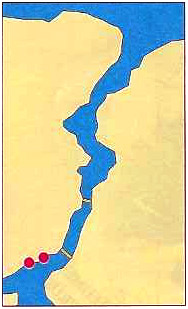
Lamartine, during a visit to Istanbul in 1833, had this to say about Dolmabahce: “It could be a palace of amphibians, for however slight the wind on the Bosphorus, it stirs up snares that sheet the I windows and fling their foam into the ground-floor apartments. Even the steps leading into the palace tread water. Grillework gates open onto the sea from both the courtyard and the gardens. Here there are sheds for the caiques and baths for the sultans, who can swim in the sea sheltered by the slatted shutters of their salon.”
Ferries sail from Eminonii for the villages along both shores of the Bosphorus, or Bogazigi in Turkish,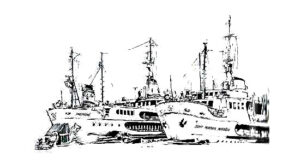 meaning “strait”. The villages along the Bosphorus, some of which date back to the period of the ancient city of Byzantium, have in the past fifty years been, for the most part, amalgamated into the urban sprawl of Istanbul. Nevertheless, they still retain a village-like quality, particularly on the upper Bosphorus, where many of the men continue to earn their living as fishermen. Any description of the Bosphorus involves the names Rumeli and Anadolu, for these are used in referring to the opposing continental shores of the strait, the first to the European side and the second to the Anatolian or Asian side.
meaning “strait”. The villages along the Bosphorus, some of which date back to the period of the ancient city of Byzantium, have in the past fifty years been, for the most part, amalgamated into the urban sprawl of Istanbul. Nevertheless, they still retain a village-like quality, particularly on the upper Bosphorus, where many of the men continue to earn their living as fishermen. Any description of the Bosphorus involves the names Rumeli and Anadolu, for these are used in referring to the opposing continental shores of the strait, the first to the European side and the second to the Anatolian or Asian side.
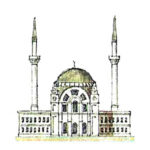
The Bosphorus is usually serene, though even on the calmest of days one can feel its power as the mass of water sums between the continents. It is beautiful at any time, day or night and in all seasons, but particularly under a full moon, which rises out of the hills on the Asian side and casts a silver path across the strait to the European shore, a phenomenon that the Turks call mehtap.
The first full moon in autumn usually marks the beginning of the season for the Bosphorus fishermen, for it is then that great schools of later, a small bluefish, make their way down the strait. The fishermen use a rowboat called a sandal, derived from the Venetian word sandalo. Most of the vessels are now equipped with outboard motors, and they all have a bright lamp which is used to shine down into the water to attract the fish. As the Bosphorus ferry heads up along the European shore it passes the docks at Galata after which can be seen a collection of monuments in Tophanc, a village which surrounds the old marine arsenal of the same name.
Designed by Nikogos Balyan, grandson of Kirkor Balyan, the Dolmabahce Mosque was completed in 1853. A year later, Nikogos added the cut-stone clock tower to the north. The tower is 88 feet tall, making it one of the most prominent landmarks on the European shore of the lower Bosphorus.
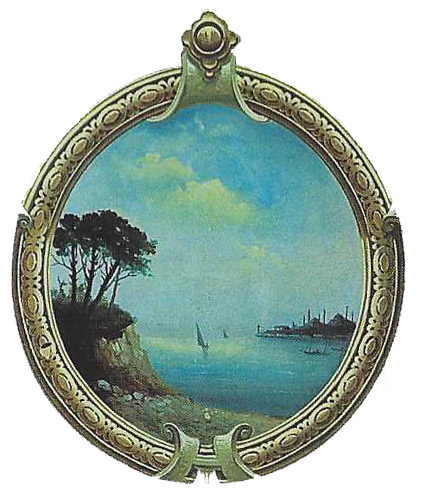
The Dolmabahce palace is by far the largest and grandest of the imperial Ottoman residences on the Bosphorus. In Byzantine times the site of Dolmabahce, which means “filled-in garden,” was an inlet on the strait. Fatih Mehmet II had the little harbor filled in and a garden laid out. In 1842, Abdul Mecit decided to construct a huge new palace on the site, giving the task to the architect Karabet Balyan and his son Nikogos, who completed the work in 1853. The main entrance to Dolmabahce Sarayt is through the gardens at its southern end. The palace faces the Bosphorus, which reflects the entire length of its 814-feet gleaming white marble facade.
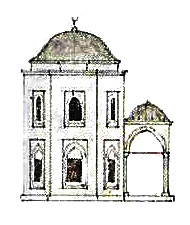
The quay; itself is about 650 yards long. Inside, the -iipalace consists mainly of a great hall flanked by two main wings containing the state rooms and royal apartments, with the selamik on the south side and the harem on the north. The complex also includes quarters for the staff who lived in, bringing the total number of rooms to 285, among them 43 salons and 6 hammams.
About 300 yards beyond Dolmabahce Sarayi the ferry stops at the Besiktas Iskele. In the park behind this landing stands a statue of the famous Ottoman Admiral Hayrettin Pasa, known in the West as Barbarossa. The Admiral’s turbo, or tomb, is opposite the sculpture.
South of the Beiktas Iskele we come to the Deniz Milzesi or Naval Museum. The most famous item in the

collection is a chart of the Atlantic coast of North America drawn in the 16th century by Piri Reis, the great Ottoman navigator. The museum houses a collection of pazar caiques, the beautiful rowing barges that ferried the sultans to and from their palaces and yams on the Bosphorus and the Golden Horn.
In the 18th century, Princess Halide had a summer palace built at Besiktas, from designs by the painter Melling.
The white-marble seafront facade of Dolmabahce is bordered by a 650-yard-long quay.